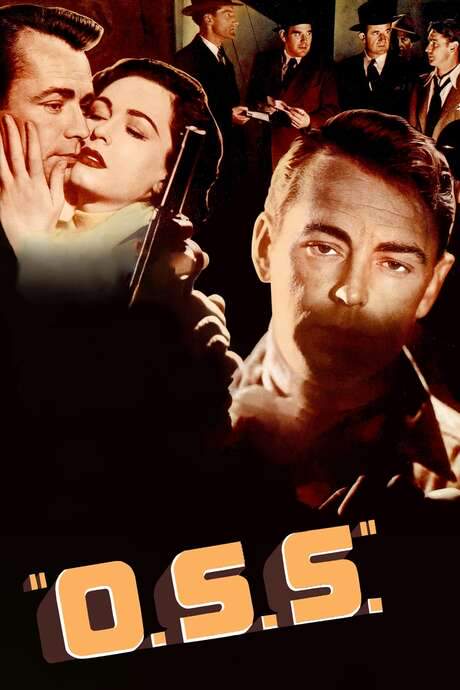
The Scarlet and the Black
Year: 1983
Runtime: 143 mins
Language: English
Director: Jerry London
Gregory Peck portrays Father Hugh O’Flaherty, a Vatican priest who during 1943‑45 shelters downed Allied pilots, escaped POWs and Italian resistance families. He builds a network that ferries thousands to safety, operating under the Gestapo’s gaze, prompting the Nazis to plot his assassination the moment he leaves the Vatican, risking his own life.
Warning: spoilers below!
Haven’t seen The Scarlet and the Black yet? This summary contains major spoilers. Bookmark the page, watch the movie, and come back for the full breakdown. If you're ready, scroll on and relive the story!
The Scarlet and the Black (1983) – Full Plot Summary & Ending Explained
Read the complete plot breakdown of The Scarlet and the Black (1983), including all key story events, major twists, and the ending explained in detail. Discover what really happened—and what it all means.
In September 1943, Rome lies under German occupation after Italy surrenders to the Allies, and the Vatican becomes a fragile buffer between conquerors and the city’s civilians. From the Vatican’s windows, the Pope John Gielgud watches as the occupiers flirt with sovereignty in a startling way: the suggestion of painting a white line across St. Peter’s Square to delineate Vatican limits. The Pope does not voice a protest, but the moment he notices the line has already begun, a quiet symbol of the Vatican’s precarious independence is etched into the city’s daily life.
Opposing the crumbling order is Monsignor Hugh O’Flaherty [Gregory Peck], an Irish-born priest who uses the moral authority of the Church to mount a discreet, life-saving network. He builds an underground operation that shelters escaped POWs, Jews, and refugees, guiding them toward safe havens and escape routes within and around Rome. O’Flaherty’s work is far from solo; he relies on a committed circle that includes Francesca Lombardo [Olga Karlatos], a widowed local who becomes a steady ally, and her daughter Guila Lombardo [Fabiana Udenio], whose youth and courage help camouflage the group’s activities. The Vatican’s own diplomats and clergy also provide cover, creating a web of protection that reaches into government buildings, monasteries, and family homes.
Yet the network faces relentless pressure from Colonel Herbert Kappler [Christopher Plummer], the SS Head of Police in Rome, who interprets neutrality as weakness and intelligence as a threat to his control. Kappler’s pursuit is methodical and brutal: he uses threats, intimidation, and coercive promises to try to force Rome’s Jews, POWs, and dissidents back into the hands of the Nazis. He pushes for drastic measures and grows increasingly frustrated as O’Flaherty’s clever disguises, careful planning, and audacious small wins chip away at his authority. Kappler’s wife, Minna Kappler [Barbara Bouchet], and others outside the immediate circle also become casualties of his aggressive campaign as the city’s tensions rise.
The Nazis set up a Jewish council in Rome to act as mediators, demanding sops in gold and currency in exchange for “protection.” O’Flaherty refuses to abandon principle and comes up with a bold counterproposal: he offers enough gold and money to fulfill the Nazis’ demands, but with strings attached that ultimately reveal the hollowness of the Nazis’ promises. The plan tests the limits of Vatican neutrality, and Kappler double-crosses the arrangement, deporting Jews to camps he claimed did not exist. The resulting momentum pushes O’Flaherty to improvise again and again, using courage, careful planning, and a deep faith that refuses to abandon those who have nothing left to lose.
The resistance is not without setbacks. Kappler’s efforts to crush the network intensify, and several of O’Flaherty’s friends are arrested or killed, including Father Morosini [Angelo Infanti], whose faith and sacrifice underscore the cost of this perilous mission. Kappler’s vendetta grows personal, especially after an assassination attempt on O’Flaherty nearly succeeds, a failed strike that is thwarted by the monsignor’s boxing skills and quick reflexes. The danger also touches the circle through a security breach: an American soldier named Jack, Lt. Jack Manning [John Terry], is captured by the Nazis and his code book is seized, threatening to unravel months of careful concealment and rescue work.
In a tense scramble to avert disaster, O’Flaherty engineers a daring ruse to free Jack. He convinces Kappler to autograph a release for the prisoner, then uses that signature to forge a release form that allows Jack to slip away. The rescue operation regroups, and the network adapts with renewed resolve, determined to protect as many lives as possible in a city under siege from both internal and external enemies. The team’s ingenuity—disguises, code words, safe houses, and rapid evacuations—continues to save lives even as the German grip tightens.
As the Allies land in Italy and begin to press north toward Rome, the city’s fortunes slowly swing in favor of liberation. Kappler, meanwhile, grows more anxious about his family’s safety and appeals to O’Flaherty for mercy, asking him to intervene on their behalf. The monsignor’s response is blunt and principled: mercy must be earned, not granted as a mere courtesy, and he refuses to offer forgiveness without repentance. He departs with a moral warning that Schmerz and guilt must be faced, a moment that crystallizes the film’s central conflict between mercy and justice.
When Rome finally enters a new chapter of freedom in June 1944, the people celebrate, and the lovers at the heart of the story—Jack and Guila—announce their engagement, a quiet symbol of renewed life amid years of peril. The victory is tempered by the knowledge that many did not survive, a truth acknowledged in the film’s somber end. Kappler is captured in 1945 and interrogated by the Allies, where he discovers that his wife and children were smuggled to Switzerland with the help of those he once tried to destroy. When pressed about who helped them, Kappler quietly concedes that he does not know.
The film closes with a reflective epilogue: O’Flaherty receives decorations from several Allied governments for his wartime bravery and humanitarian work. Kappler is sentenced to life imprisonment, and his monthly visits from O’Flaherty become a stark reminder of the man he once was and the mercy a single priest—standing at the intersection of faith and justice—chooses to extend. In a final, poignant turn, Kappler converts to Catholicism and is baptized in 1959, a gesture that offers a bittersweet coda to a story of risk, resilience, and restraint in the face of overwhelming cruelty.
Last Updated: October 09, 2025 at 14:22
Unlock the Full Story of The Scarlet and the Black
Don't stop at just watching — explore The Scarlet and the Black in full detail. From the complete plot summary and scene-by-scene timeline to character breakdowns, thematic analysis, and a deep dive into the ending — every page helps you truly understand what The Scarlet and the Black is all about. Plus, discover what's next after the movie.
The Scarlet and the Black Timeline
Track the full timeline of The Scarlet and the Black with every major event arranged chronologically. Perfect for decoding non-linear storytelling, flashbacks, or parallel narratives with a clear scene-by-scene breakdown.

Similar Movies to The Scarlet and the Black
Discover movies like The Scarlet and the Black that share similar genres, themes, and storytelling elements. Whether you’re drawn to the atmosphere, character arcs, or plot structure, these curated recommendations will help you explore more films you’ll love.
Explore More About Movie The Scarlet and the Black
The Scarlet and the Black (1983) Scene-by-Scene Movie Timeline
The Scarlet and the Black (1983) Movie Characters, Themes & Settings
The Scarlet and the Black (1983) Spoiler-Free Summary & Key Flow
Movies Like The Scarlet and the Black – Similar Titles You’ll Enjoy
Scarlet (2023) Story Summary & Characters
Monsignor (1982) Detailed Story Recap
The Assisi Underground (1985) Movie Recap & Themes
Scarlet Pages (1930) Full Summary & Key Details
The Scarlet Coat (1955) Plot Summary & Ending Explained
Black Shirt (1933) Ending Explained & Film Insights
The Colditz Story (1955) Ending Explained & Film Insights
I Escaped from the Gestapo (1943) Ending Explained & Film Insights
The Forbidden Christ (1951) Spoiler-Packed Plot Recap
Rome, Open City (1945) Film Overview & Timeline
The Green Devils of Monte Cassino (1958) Detailed Story Recap
Hangmen Also Die! (1943) Full Movie Breakdown
The Scarlet Blade (1963) Plot Summary & Ending Explained
The Cardinal (1963) Full Movie Breakdown
O.S.S. (1946) Complete Plot Breakdown

















